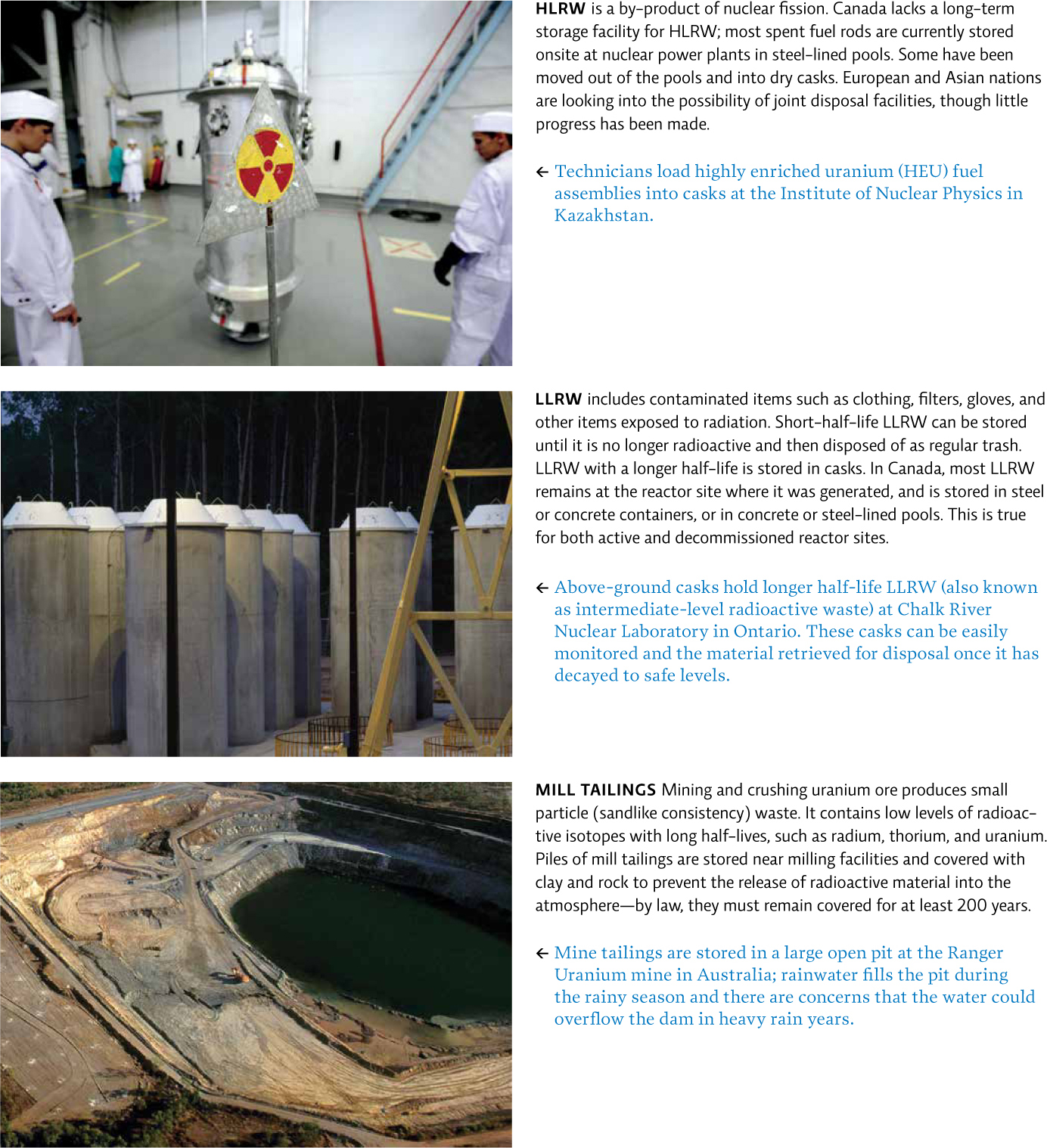23.5 The generation of nuclear waste is a particularly difficult problem to address.
The reactors weren’t the only problem. Experts around the world were particularly concerned about Fukushima’s radioactive waste.
To understand why, it helps to know a little about radioactive waste. In general, there are two kinds: low-level radioactive waste and high-level radioactive waste.
426
Low-level radioactive waste (LLRW) is material that has low amounts of radiation relative to its volume, and can usually be safely buried. This includes clothing, gloves, tools, etc., that have been exposed to radioactive material. In 2010, Canada produced over 5000 cubic metres of LLRW and had accumulated over 2.3 million cubic metres.
High-level radioactive waste (HLRW) is another story. As its name suggests, it’s more reactive than LLRW; in fact, because so many radioactive by-products are created in fission reactions, HLRW is actually much more radioactive than the original fuel rods. In 2010, Canada produced almost 300 cubic metres of HLRW and had more than 9000 cubic metres of the stuff in storage. HLRW includes nuclear fuel rods, other fuel forms, and some liquids.
So far, we have no safe, reliable, long-term storage plan for this waste. Spent fuel rods are stored onsite in steel-lined pools, where at least some isotopes—those with short half-lives—can decay to safe levels. Isotopes with longer half-lives require more time to reach this point. Because the isotopes produced in the fission reaction or by the decay of these isotopes are all mixed together, the waste has to be stored for as long as it takes the longest half-life material to decay to safe levels—in some cases that’s more than 2 million years.
Radioactive waste in Canada is stored in concrete or steel containers and pools at numerous sites across the country, none of which are permanent. Most radioactive waste is in interim storage at the nuclear power and radioisotope production reactor sites where they were generated. Some HLRW goes to Atomic Energy of Canada Limited (AECL) research sites in Manitoba and Ontario, or to facilities in the United States. All Canadian storage sites, including those belonging to the AECL, will have to be decommissioned or remediated in the future to comply with Canada’s Nuclear Fuel Waste Act.
Permanent storage awaits development of long-term waste management facilities. The Canadian strategy is to create a “deep geological repository” in the largely impermeable, granitic precambrian (or “Canadian”) shield, which covers most of eastern and northern Canada. This strategy has been criticized by environmental groups as being an “out-of-sight, out-of-mind” solution; however, it is the only plan we have thus far. For this plan to work, we would also need to develop plants to properly containerize the waste before long-term storage. Even if a long-term storage option is approved and constructed, we still have the problem of how to safely transport nuclear waste across the country, a dilemma not likely to be resolved in the near future. [infographic 23.7]

Meanwhile, back at Fukushima, radioactive waste posed yet another deadly threat. Each of the six reactors had its own swimming pool-like container where used radioactive fuel was stored. The pools were full of years’ worth of waste, and they relied exclusively on water to prevent overheating. If just one of those pools ran dry, the consequences would be catastrophic: by some estimates, a worker standing next to a dry pool could receive a fatal dose of radiation in just 16 seconds.
On March 13th, just as experts around the world were contemplating such an event, a fire broke out around the spent fuel pool near reactor No. 4.